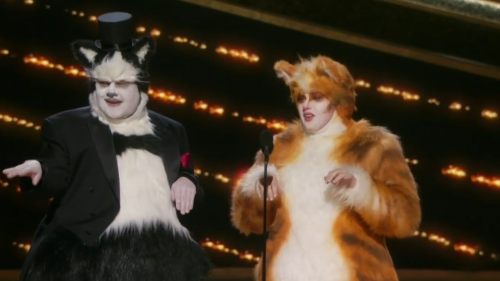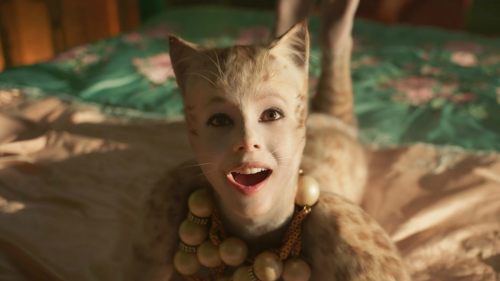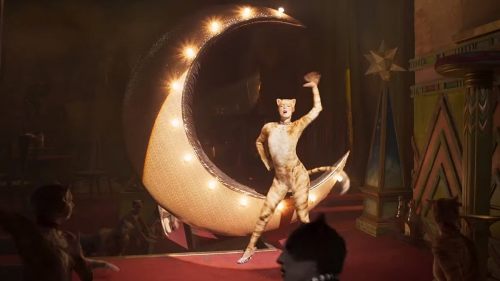The True Nightmare Of CATS Is How Dull It Is
You would be forgiven, reading the performative disaster-tourism dunkpieces propagating gleefully across the Internet, for thinking that Tom Hooper’s Cats is an eldritch work of fetish horror, populated entirely by nightmares from some deep animal id. And sure, parts of the movie - mostly contained to Rebel Wilson’s "Old Gumbie Cat" number - definitely fulfil that doom prophecy. But viewed from outside the context of pirated clips on Twitter, and inside the context of the complete film, that’s not really what the movie is.
Cats was never not going to be weird. It was always going to be an adaptation of the stage show - a stage show that’s become a pop cultural icon in its nearly forty years of continuous production. We all generally knew what this was going to look like, and audiences’ refusal to accept dancers playing anthropomorphised cats is honestly more on their lack of imagination than on the movie. Or perhaps, in Film Twitter’s case, it’s a wilful refusal to engage honestly with a fantasy musical they’d spent months revving up to pillory.
Even the visual effects realistically only take ten minutes or so to get accustomed to, same as the stage costumes - and while they're often sub-par, they're not quite as diabolical as reported. Given the ridiculously difficult job and unrealistic schedule foisted upon the film's VFX artists, the work seen in the film is actually pretty impressive. Some shots even look genuinely great, while the rest bear the uncanny-valley hallmarks of rushed rotoscoping and compositing that simply needed more time to fully complete. Anecdotal evidence pins the blame on the same systemic problem in planning, resourcing, organisation, and communication that’s affected countless other effects pictures; Cats just happens to be the first movie the industry’s ruthless underbidding and constant crunch has fully broken.
No; Cats’ flaws run deeper than the simple discombobulation of seeing people pretend to be animals, and few critics seem interested in talking about that. So here we are. I'm not here to defend the movie; I just want to talk about the actual movie.
In the power rankings of potential Cats movies we could have received, my preferences would go like this:
- The Cats film I hoped for in this article;
- The Lovecraftian/Cronenbergian terror implied by reviews, which would at least have been perversely entertaining;
- The film of the show that came out in 1998;
- Cats (2019).
Cats, the musical, has only spectacle going for it. The reason you go to see Cats is to see world-class dancers performing incredible choreography while singing Andrew Lloyd Webber’s often strange and overcomplicated songs. You don’t go to a dance musical based on a book of poems for a story. You go for a capital-S Show. It wouldn’t work without the significant dance component - for example, as an animated film with more realistic cats - because then you’d have to actually engage with the narrative, of which there is, famously, precious little. All I’m saying is that it’s futile to pick narrative holes in a script literally transcribed from lightweight eighty-year-old TS Eliot poems. Luckily, cinema is known for spectacle, and the tools of filmmaking are capable of capturing music and dance in a truly kinetic way.
...in theory, anyway. Hooper resists spectacle at nearly every turn in his film. Though Andy Blankenbuehler’s choreography is pretty good throughout, even great at times, it doesn’t matter when the dancers are obscured by Hooper’s many inexplicable directorial choices. That Hooper opens the film with its main character tied up in a bag is a fitting visual metaphor for this, his second attempt at a big-budget, all-star musical: grim, hemmed-in, and flailing for something to hold on to.
Ninety percent of directing is casting, they say, and Cats’ casting - a hodgepodge of “name” actors, musical theatre performers, and popstars - doesn’t reflect terribly well on Hooper’s decisions. That’s not just because some cast clearly can’t sing and dance and act at the same time, with even Taylor Swift spared having to do much dancing; many of the film actors simply lack the dynamism required to sell a musical. Stage veterans Ian McKellen and Judi Dench salvage some of their dignity with their quieter roles, but in order to do so, their songs are brought way down in tone from their more extravagant stage versions. As for the rest of the "name" cast, they're generally eclipsed by the performers who come directly from musical theatre.
Film Crit Hulk has written on this subject before, so I won’t go on at length, but Tom Hooper’s shot choices and blocking in Cats generally range from uninteresting to unmotivated to simply bizarre. He shoots entire songs in medium closeup or medium wide shots. Some numbers don’t feature much dance at all; others are presented through handheld camera coverage and fast cutting that do the dancers a disservice. It's much the same thing Hooper did to Les Miserables several years ago. The overall effect is one tending away from the fun and wonder one would think necessary in adapting this show. When you shoot dance, you have to shoot it like dance; applying a purely dramatic lens only confuses things. I saw the movie with a pair of musical theatre professionals, one a longtime Cats fan, and both scoffed frequently at the lack of showmanship on display.
Worst of all is “Memory,” a song oozing with emotion that demands a cinematic treatment to match, which Hooper covers almost entirely with static closeups of Jennifer Hudson. This brings up another interesting point, regarding the much-puzzled-over Actual Story Of Cats. All these cats compete to be sent to the Heaviside Layer, implicitly a death and rebirth and explicitly kind of a hot-air-balloon disappearance. Hudson’s character, Grizabella, is written as a melancholic older character, shunned by society, taking a bittersweet look at glory days past and drawn-out existence present, becoming the Jellicle* Choice by virtue of the extent of life lived.
At least that’s how it is in the show. Hudson’s screen casting makes her an inescapably younger figure, while her performance and Hooper’s direction presents her as an abused, depressed, actively persecuted “fallen woman.” That’s unpleasant enough, but it takes on a new dimension when put alongside the ending. In the film, it plays very strongly like Grizabella becomes the Jellicle Choice simply because she’s the most depressed - and her “prize” is to fly away to her death. It’s borderline offensive from a mental health perspective, rendering the Heaviside Layer - death - more a release from misery than a place of rest at the end of one’s natural life.
A few sequences manage to rise above. “Mungojerrie and Rumpleteaser” - one of the few sequences without a single movie star in sight, with one performer (Naoimh Morgan) straight out of a Cats stage production - is a whimsical delight with just the right level of weird energy. Likewise, “Skimbleshanks, The Railway Cat” is designed around the impeccable tap chops of Royal Ballet principal Steven McRae, but it’s also the only sequence in the movie to contain a proper wide shot. That moment - when the cats tapdance across a rail bridge, revealing the Thames, the moon, and the London skyline - is genuinely joyful, but its cinematic qualities only serve to highlight the gulf between it and the rest of the film.
Finally, the Jellicle Ball - an arcane centrepiece dance number in the show and film - is one of the film’s rare moments where choreography is allowed to do some storytelling by itself. It’s the only time Hooper’s film actually feels like an adaptation of the stage show; there’s emotion and atmosphere in the physicality that doesn’t come out anywhere else. Unfortunately, even that scene rapidly devolves into a series of individual dance breaks - many of which don’t fit the Edwardian setting or lend much character insight. A wasted opportunity to lift the film to a more ecstatic level.
Ultimately, Cats may simply not suit a film adaptation at all. It’s a near-pure dance musical with a threadbare story - expanded by Hooper’s magical kidnapping additions, but not necessarily improved. It has to be a show above all else; bringing it down to a street-level drama (by comparison) is a mistake. Imagine a Cats adaptation with the energy of dance movies like Step Up 4 or Climax, or what it looks like we’ll see in In The Heights. That’s the kind of energy Cats needs. That’s the kind of energy Cats (2019) lacks.
Failing that: I wish this film was the consistently wild hallucinogenic ride it’s been hyped as. I’ve seen plenty of films purely to witness strange creative decisions. But so many of the decisions in Cats push the film away from even that into the now-familiar realm of eye-rolling Tom Hooper boneheadedness. If you’re going to make a movie of Cats, make a fucking movie of Cats. Lean into it - the music, the dance, anything that makes the stage show the odd spectacle that it is. Hooper’s film isn’t a spectacle even in the car-wreck sense. For the most part, it’s just dull.
* Since so many tweets have pondered this particular tangible detail, whether or not they actually cared about the answer: "Jellicle cat" is TS Eliot's cutesy corruption of "dear little cat," a phrase that Judi Dench's character literally utters directly after "Jellicle cat" in the text of the movie. You'd think a culture obsessed with "chonky cattos" and "heckin' floofy pupperinos" would understand this sort of thing.



